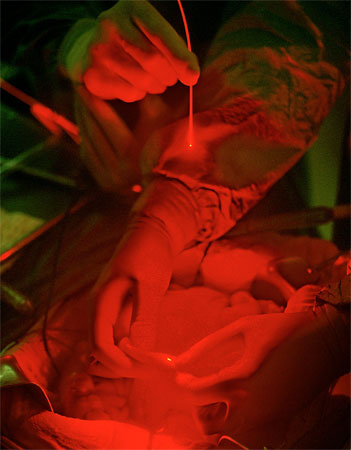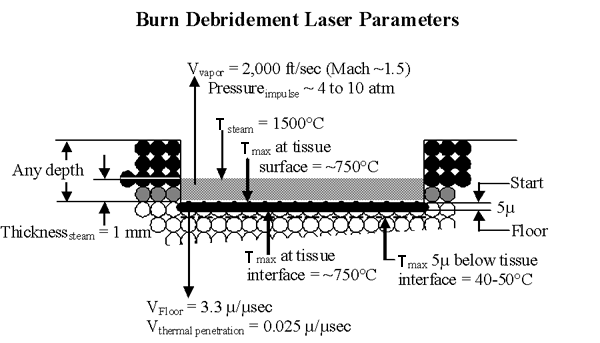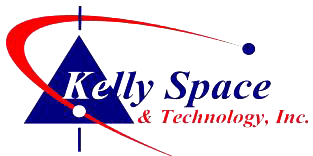Portable Burn Debridement Laser (PBDL)
Need for Laser Debridement
Burn wounds are exceedingly traumatic to the human body. For modest injuries, as many as a dozen surgical procedures are required for sufficient treatment with a satisfactory outcome. For more severe cases hospitalization requirements can range from one to two years in a special burn unit facility at costs that exceeds 1 to 2 million dollars. Regarding the human element, the pain and suffering is nearly unbearable, with increased probability of complications exacerbated by the length of time and number of procedures endured. A key medical risk is the enormous blood loss during traditional surgical procedures to remove dead tissue prior to grafting operations. In addition to burn treatment, many types of skin ulcers, such as bed sores, need more effective treatment to reduce the risk of gangrene and other infection.
The Solution
Kelly Space & Technology, Inc. (KST) is developing a Portable Burn Debridement Laser (PBDL) system that will showcase the capabilities of KST’s laser treatment technology. Based on the core KST knowledge acquired with the development of laser de-coating systems, the portable burn wound debridement system will share core concepts and technologies while being tailored for medical use by medical professionals.
The KST team will define system and component performance requirements, design system packaging, perform system integration, verify system performance, and provide the completed system for treatment efficacy evaluation. KST’s extensive experience in CO2 laser systems development and integration helps to minimize technical non-performance risk.
The PBDL System will consist of a significant number of individual, highly specialized components. These components range from high precision steering optics, sophisticated lasing cavity components, purpose built process controls tailored for physician use, and high power electrical systems required to drive the lasing process. These systems and components are usually built to order and require specialized tooling in the manufacturing process. The PBDL system will be comprised of several major subsystems each effecting overall system operation. These subsystems consist of a high performance pulsed laser, laser beam conditioning optics, laser beam delivery system, control system electronics, and system packaging. The surgeon will handle the delivery through an end effecter designed for comfort and precision hand held operation. All system optics from the laser origin to the end effecter will be contained within a sealed closed beam system to mitigate safety hazards and to maintain optical performance by preventing optical contamination. System controls will consist of a surgeon operated foot switch activating laser output, emergency shut off switch, and an embedded system-monitoring computer. The PBDL system will comply with all applicable federal and state regulations regarding the construction and safe operation of high power laser systems.

The Portable Burn Debridement Laser (PBDL) treatment procedure developed to address this need reduces blood and body fluid loss by up to a factor of ten while speeding up each surgical procedure and reducing the total number of required procedures. This is less traumatic to the patient and significantly lowers the chances of complications, resulting in faster recovery at substantially lower cost. The laser treatment may also increase the probability of successful grafts while reducing the risk of infection.
Evolution of the Laser Burn Debridement Procedure
The first attempts at laser debridement were not very promising. Existing laser technology simply did not permit a viable procedure and actually extended the burn region into underlying tissue. This necessitated the use of instrumentation to determine proximity of live tissue so that the laser interaction depth could be carefully controlled. Many of these attempts to conduct depth assessment were simply unsuccessful.
A viable procedure, however, evolved from a development program to strip paint from sensitive aircraft substrates. The laser and beam delivery system has been developed and field implemented and is currently being demonstrated for the United States Marine Corps for use in corrosion prevention and equipment maintenance. This laser technology is equally applicable to coating removal from thin-skin aircraft as well as human skin ablation. Each of these applications requires that heat transfer into the underlying substrate or tissue be eliminated or substantially reduced. Hence, the paint-stripping laser methodology was extended to burn-debridement studies conducted during initial live animal testing in 1990. Results were highly successful and the previously experienced difficulties with other laser technologies were non-existent.
The demonstrated coating removal laser technology solves the problems associated with the previous laser technologies and virtually eliminates heat transfer to surrounding healthy tissue or internal organs. Key technology advantages include:
The laser beam is collimated, not focused, which spreads the laser energy over a wider surface area.
No sensitivityto stand-off distance, therefore the laser energy remains constant at distances up to several feet from the treated surface.
Laser operation is nearly independent of surgeon’s motion.
Thermal build-up can be automatically eliminated by “slaving” laser pulse repetition rate to surgeon’s motion.
No need for instrumented control, but the surgeon’s view may be enhanced by magnification TV monitor display, if desired
Debris and emissions are fully and automatically suctioned away and may be fully contained if necessary.
Articulated arm used to deliver beam to surgeon’s hand-held applicator ensures easy viewing and access to treated surfaces.
The results ensure that blood and body-fluid losses are nearly eliminated, leaving clean, living, undamaged tissue site for grafts. The laser treatment significantly increases the speed of debridement procedures compared to tangential excision, enabling many procedures to be completed in one operation and is expected to significantly lower trauma to the patient, with less pain, a faster recovery, fewer procedures, and less complications.

Where:
Velocity floor = 3.3 microns/microsecond (133 inches/sec)
Velocity thermal penetration = 0.025 microns/microsecond (1 inch/sec)
Period (τ pulse) = 1.5 microseconds
Period (τ cool) = 10,000 microseconds
Temperature (Τ max) at tissue surface = ~750°C
Temperature (Τ max) at tissue interface = ~100°C
Temperature (Τ max) 5 microns below tissue interface = ~40-50°C
Assumes Scan Scenario
Flux – 25 joules/cm 2 5 overlaps/beam width
Τ pulse = 1.5 microseconds Footprint = 4 cm 2 (1 cm x 4 cm)
Peak power = 1.7 megawatts/ cm 2 Velocity scan = 20 cm/sec
Repetition rate = 100 pulses/second Re-scan period = <1 second
1 Kilowatt (kW) average power laser removes 0.5 ft 2 mm thick tissue/minute
Conclusions
A laser-based burn-debridement procedure has been developed and proven effective on live animals.
A unique set of laser parameters and method of application has been theoretically developed and experimentally verified.
Initial burn debridement tests on a live pig, followed by skin grafts, were 100% successful:
Blood loss and body-fluid loss was virtually eliminated.
The grafts “took” completely.
The time required for surgery was substantially reduced over conventional tangential excision-control procedures.
A fully manual procedure was demonstrated without the aid of instrumentation or feedback control.
A laser and beam delivery system developed for aircraft radome stripping applications was used to conduct the first animal studies.
A down-scaled laser designed specifically for surgical applications is now in the early stages of development for specific application to burn debridement and skin abrasion treatment.
